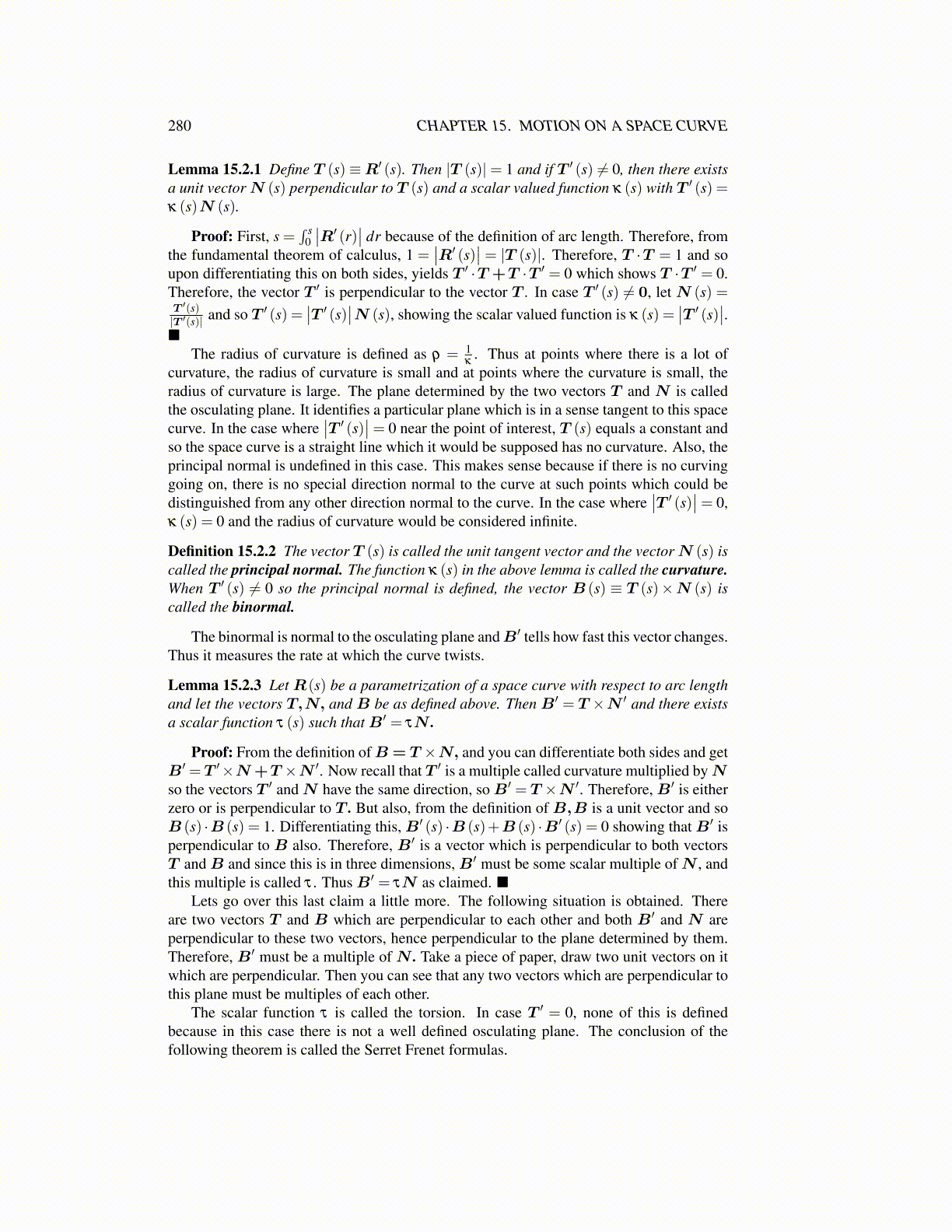
280 CHAPTER 15. MOTION ON A SPACE CURVE
Lemma 15.2.1 Define T (s)≡R′ (s). Then |T (s)|= 1 and if T ′ (s) ̸= 0, then there existsa unit vector N (s) perpendicular to T (s) and a scalar valued function κ (s) with T ′ (s) =κ (s)N (s).
Proof: First, s =∫ s
0
∣∣R′ (r)∣∣ dr because of the definition of arc length. Therefore, fromthe fundamental theorem of calculus, 1 =
∣∣R′ (s)∣∣ = |T (s)|. Therefore, T ·T = 1 and soupon differentiating this on both sides, yields T ′ ·T +T ·T ′ = 0 which shows T ·T ′ = 0.Therefore, the vector T ′ is perpendicular to the vector T . In case T ′ (s) ̸= 0, let N (s) =T ′(s)|T ′(s)| and so T ′ (s) =
∣∣T ′ (s)∣∣N (s), showing the scalar valued function is κ (s) =∣∣T ′ (s)∣∣.
■The radius of curvature is defined as ρ = 1
κ. Thus at points where there is a lot of
curvature, the radius of curvature is small and at points where the curvature is small, theradius of curvature is large. The plane determined by the two vectors T and N is calledthe osculating plane. It identifies a particular plane which is in a sense tangent to this spacecurve. In the case where
∣∣T ′ (s)∣∣= 0 near the point of interest, T (s) equals a constant andso the space curve is a straight line which it would be supposed has no curvature. Also, theprincipal normal is undefined in this case. This makes sense because if there is no curvinggoing on, there is no special direction normal to the curve at such points which could bedistinguished from any other direction normal to the curve. In the case where
∣∣T ′ (s)∣∣= 0,κ (s) = 0 and the radius of curvature would be considered infinite.
Definition 15.2.2 The vector T (s) is called the unit tangent vector and the vector N (s) iscalled the principal normal. The function κ (s) in the above lemma is called the curvature.When T ′ (s) ̸= 0 so the principal normal is defined, the vector B (s) ≡ T (s)×N (s) iscalled the binormal.
The binormal is normal to the osculating plane and B′ tells how fast this vector changes.Thus it measures the rate at which the curve twists.
Lemma 15.2.3 Let R(s) be a parametrization of a space curve with respect to arc lengthand let the vectors T,N, and B be as defined above. Then B′ = T ×N ′ and there existsa scalar function τ (s) such that B′ = τN.
Proof: From the definition of B = T ×N, and you can differentiate both sides and getB′ =T ′×N +T ×N ′. Now recall that T ′ is a multiple called curvature multiplied by Nso the vectors T ′ and N have the same direction, so B′ = T ×N ′. Therefore, B′ is eitherzero or is perpendicular to T. But also, from the definition of B,B is a unit vector and soB (s) ·B (s) = 1. Differentiating this, B′ (s) ·B (s)+B (s) ·B′ (s) = 0 showing that B′ isperpendicular to B also. Therefore, B′ is a vector which is perpendicular to both vectorsT and B and since this is in three dimensions, B′ must be some scalar multiple of N , andthis multiple is called τ . Thus B′ = τN as claimed. ■
Lets go over this last claim a little more. The following situation is obtained. Thereare two vectors T and B which are perpendicular to each other and both B′ and N areperpendicular to these two vectors, hence perpendicular to the plane determined by them.Therefore, B′ must be a multiple of N. Take a piece of paper, draw two unit vectors on itwhich are perpendicular. Then you can see that any two vectors which are perpendicular tothis plane must be multiples of each other.
The scalar function τ is called the torsion. In case T ′ = 0, none of this is definedbecause in this case there is not a well defined osculating plane. The conclusion of thefollowing theorem is called the Serret Frenet formulas.